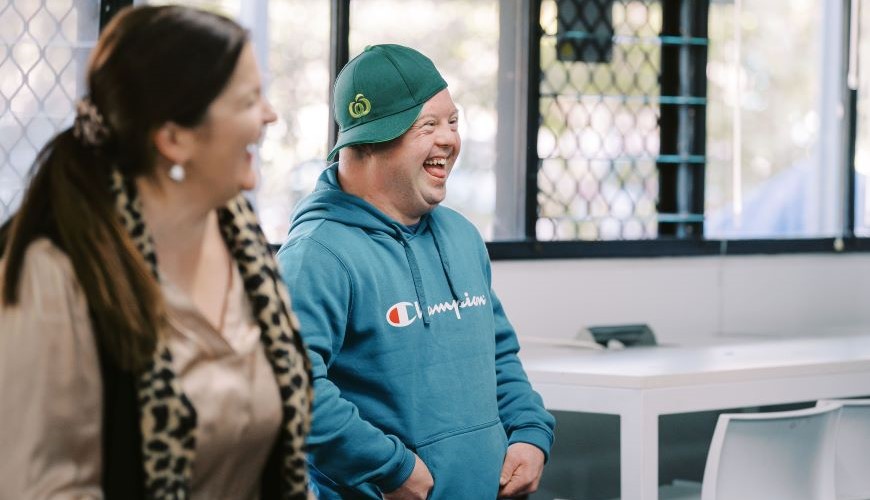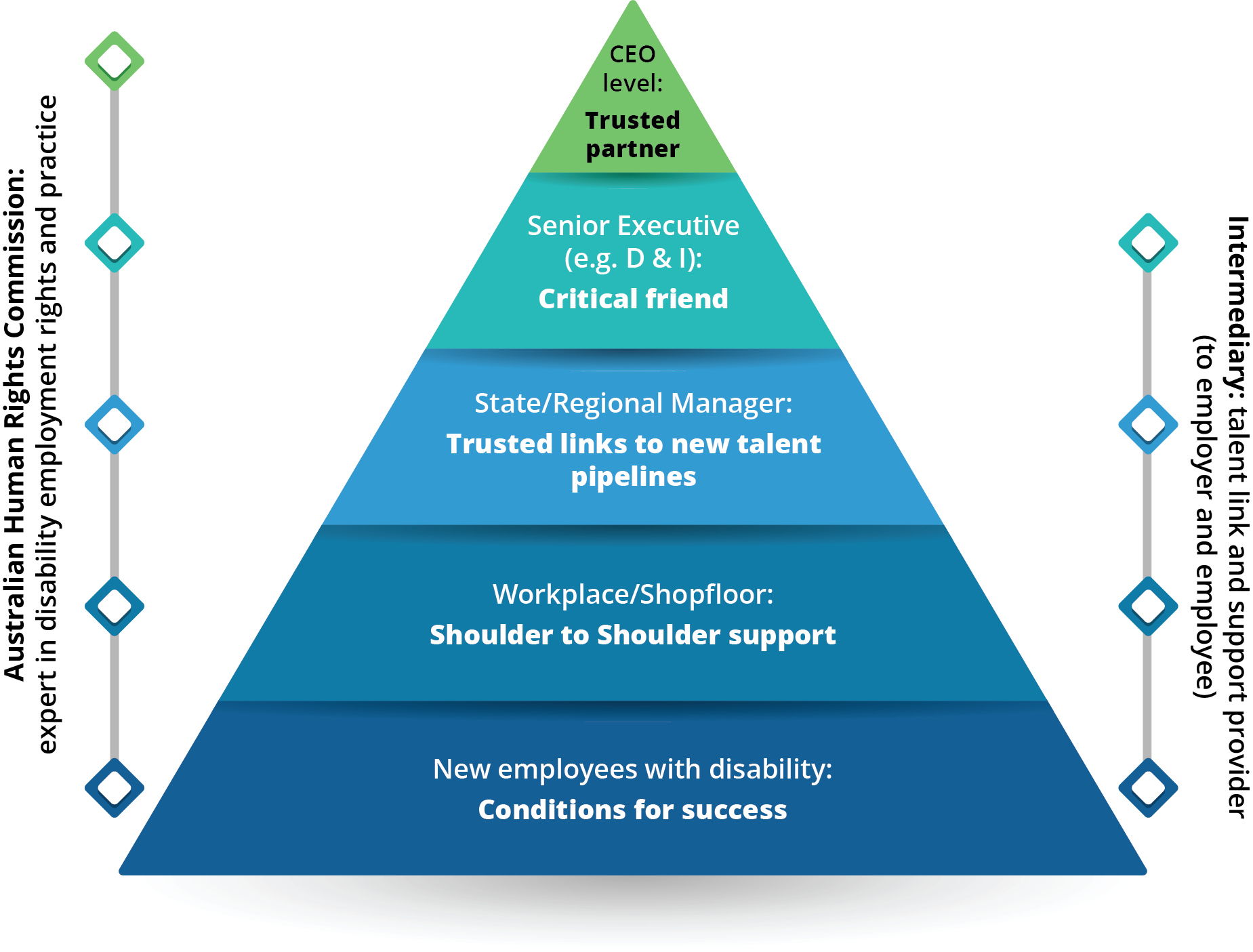IncludeAbility Evaluation

The Centre for Social Impact at Swinburne University completed an independent evaluation of the IncludeAbility Project 2020-2023.
Introduction
The Centre for Social Impact at Swinburne University has completed an independent evaluation to assess the effectiveness of the IncludeAbility project. The evaluation involved stakeholder interviews and secondary data analysis.
This is a summary of the Evaluation of the Australian Human Rights Commission ‘IncludeAbility’ project, 2020-2023.
On 24 November the IncludeAbility team hosted a webinar with the Centre for Social Impact Swinburne on the lessons from the IncludeAbility Project. Watch the Webinar.
Key takeaway
IncludeAbility addresses a critical human rights issue in Australian society: equal opportunities for employment for people with diverse disability. Just 53.4% of people aged 15-64 years with disability are employed, compared with 84.1% of people the same age without disability. This discrepancy has been highlighted in multiple recent inquiries including the Royal Commission into Violence, Abuse, Neglect and Exploitation of People with Disability, and the Review of the National Disability Insurance Scheme (NDIS).
IncludeAbility has identified barriers to employment of people with disability within large organisations. High-level policies supporting inclusion are not enough to achieve increased employment of people with disability. To drive change, all levels of an organisation must collaborate to remove barriers to employment, and introduce strategies to support employers and employees.
Findings
- Barriers to employment for people with disability in large organisations are complex and relate to the operating environment of each particular organisation. Therefore, those barriers must be made visible within each organisation and a bespoke approach developed to address them.
- There is not a culture within large organisations where employment candidates are routinely asked to provide information about reasonable adjustments or conditions for success within the recruitment and onboarding process. The Commission potentially has an important role to play in changing this.
- Addressing barriers within large companies requires engagement at all levels of the organisation, from the Board and CEO level to the level of the workplace. Diversity and Inclusion Executives play a crucial role in connecting various levels of the organisation.
- A culture of learning, a safe space and trusted partners supports large organisations to implement programs that can deliver employment opportunities for people with disability at scale.
- Undertaking a Pilot Employment Program supports organisation-wide learning about barriers to employment for people with disability and the development of strategies to address those barriers, which can be applied at scale.
- There is a range of providers who can support the inclusion of people with disability in workplaces, beyond Disability Employment Services (DES). Rather than focusing on a type or category of service, the focus needs to shift to the types of supports required to create employment for people with disabilities in large organisations, and the development of mechanisms to deliver those supports.
- Organisations require long term, sustained support to build their disability confidence and create employment opportunities for people with disability. Governments should work collaboratively with large organisations to enable this.
What change did IncludeAbility drive?
The IncludeAbility project aimed to support large employers to increase the employment of people with disability. The evaluation identified several key changes resulting from the project:
1. Engagement in improving employment opportunities:
- Employer Network Members gained knowledge, increased awareness, and confidence, leading to internal advocacy for disability inclusion.
2. Deepened understanding of strategies for success:
- Organisations deepened their understanding of strategies for employing people with disability at scale.
- IncludeAbility led to a commitment by some organisations to employ individuals with disabilities on full wages for a minimum of 12 weeks (Pilot Employment Program), fostering practical learning and specific strategies for success.
- There was a focus on broadening talent pipelines and adopting explicit recruitment strategies to attract candidates with disability.
3. Increased opportunities for paid employment:
- IncludeAbility supported large organisations to increase opportunities for paid employment for individuals with disabilities.
- Two Pilot Employment Program sites (Perth and Illawarra/South Coast) realised employment outcomes, with individuals with disability securing ongoing employment.
- IncludeAbility facilitated skill development, independence, and improved social and professional networks for employees with disability.
4. Opened access to new supports and talent pipelines:
- Access to talent pipelines was identified as a key barrier, and IncludeAbility addressed this by connecting large organisations to disability employment service providers (intermediaries).
- The intermediaries provided critical support during the Pilot Employment Program (i.e first 12 weeks of employment), ensuring a smooth transition for new recruits with disability and helping to address productivity issues.
The need for pilots and prototyping
The success of the Pilot Employment Programs required a tailored approach, targeting different layers of the employing organisation.
An emerging model for disability employment pilots is presented below in Figure 1. It involves the unique feature of engagement at all levels, from the CEO to new employees, with the Commission and intermediary providing specific supports.
- At the CEO level, CEOs commit to the initiative, viewing the Commission as a trusted partner for addressing social and business issues. The Disability Discrimination Commissioner plays a crucial role in engaging executive leadership and connecting with senior government members.
- At the Senior Executive level, such as diversity and inclusion leads, the Commission serves as a critical friend, offering a safe space for learning and progress. Participation in the Employer Network, training, and pilot programs connects them with like-minded individuals and organisations, fostering a culture of learning. This involvement also facilitates access to content challenging mindsets, addressing unconscious bias, and offering potential solutions.
- At the state/regional management level, the branding of IncludeAbility is valuable in uniting people across organisations around a common initiative. Involvement in the pilot shifts the focus from 'should we' to 'how do we' employ people with disability, providing access to trusted partners and supports. Local intermediaries, vetted by the Commission, help in building disability knowledge, identifying barriers, and developing strategies at this management level.
- At the workplace level, where pilot employees are located, supervisors and site managers value support from both the intermediary and the Commission. This support includes adjusting recruitment and onboarding processes, addressing individual employee needs, and building disability confidence. The Commission's trusted partners assist in problem-solving and provide a safe space for ongoing discussion.
- For new employees with disability, the pilot emphasises conditions for success, such as alternative pathways to employment, fair pay, workplace accommodations, supportive managers, and ground-level support. Intermediaries help both managers and employees in overcoming challenges.
Figure 1: IncludeAbility Pilot implementation model
-
Alt Text description of image
This is a picture depicting the way support has been provided by both the AHRC and the Intermediary to the pilot employing organisation. The employing organisation is depicted as a five level pyramid. Each level of the pyramid represents a different level of the organisation from the CEO at the top to the new employees with disability at the bottom. The AHRC is represented as a vertical box to the left of the pyramid that provides support as the expert in disability employment and rights. The Intermediary also provides support to the employing organisation and is depicted by a box to the right of the pyramid. The intermediary is the talent link and support provider to both the employer and the employee. Together the AHRC and the intermediary provide specific supports at each level of the organisation, with only the AHRC providing support as a trusted partner at the CEO level. At the Senior Executive level, the AHRC and the intermediary act as critical friends. At the State or regional manager level, both organisations work to offer trusted links to new talent pipelines. At the workplace or shopfloor level, the AHRC and intermediary provides shoulder to shoulder support. At the level of new employees with disability, both organisations ensure the conditions for the individual's success are in place.


